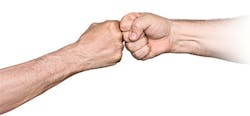Give me a high five
BY NOEL BRANDON KELSCH, RDHAP
I have always liked Howie Mandel. His sense of humor, his comedic laugh, and his trademark fist bump reflects his courageous way of dealing with a disease that hinders many people. Mandel has obsessive compulsive disorder (OCD), an anxiety disorder that produces inescapable repetitive thoughts.
For him, one area that this disease has brought to the forefront is exposure to germs, thus he utilizes the fist bump to replace shaking hands, reducing exposure to germs. Howie Mandel is brilliant!
---------------------------------------
Other articles by Kelsch
- Jenn’s vision: A true lesson in best practices
- Dentures and aspiration pneumonia
- MRSA and MSSA in the Dental Setting
---------------------------------------
There are many reasons that Howie should be concerned about shaking hands in the medical setting. Clean hands are the single most important factor in preventing the spread of pathogens and antibiotic resistance in health-care settings.1 The compliance rates for hand hygiene among health-care professionals, however, is about 40%.2 You could be spreading the diseases from your previous patient to your next patient simply by shaking hands.
In many cultures, handshakes are a way for people to communicate nonverbally, expressing everything from congratulations to pleasure in seeing someone. In medieval times, it was used as a gesture of peace showing that someone does not have a weapon and that meeting with him was safe.
The tide is changing today as science has shown a different aspect to shaking hands.
One university study looked at other concepts that can convey the same message as shaking hands and yet have a lower risk of spreading disease. The fist bump and the high five involved much less exchange of disease-causing agents.
The experiment was simple. Both researchers put sterile gloves on their right hands. One of the researchers dipped the gloved hand into a solution teeming with harmless E. coli bacteria. They then shook hands and measured the number of bacteria on the glove that had not been dipped in the E. coli solution. They did the same thing for both the fist bump and high fives.
The results were staggering. Shaking hands transmitted two times more bacteria than high fiving and 10 times more bacteria than fist bumping.
They also addressed a couple of other interesting concepts in handshakes. They looked at the duration and strength of the handshake. The high transmission level observed for handshakes does not appear to be purely a function of its large contact area. It also depends on duration and strength. Transmission is greater with increased duration and grip, which presumably increases the intimacy of association between hands.3
In a subsequent article in the Journal of the American Medical Association regarding this study, it was suggested the tradition of shaking hands with patients to reassure them be eliminated and replaced with fist bumping and high fives.
Fist bumping and high fives could be a simple method to prevent some of the transmission of disease. Other concepts such as touching the client's shoulder reassuringly with your hand and/or other alternatives should be researched. Thank you, Howie, for bringing a new concept in infection control forward and for your brave journey with OCD.RDH
References
1. http://www.cdc.gov/handhygiene/download/hand_hygiene_core.pdf
2. Gould D. J Hosp Infect 1994;28:15-30.106.
3. Mela S, Whitworth DE. American Journal of Infection Control 42 (2014) 916-7 The fist bump: A more hygienic alternative to the handshake
NOEL BRANDON KELSCH, RDHAP, is a syndicated columnist, writer, speaker, and cartoonist. She serves on the editorial review committee for the Organization for Safety, Asepsis and Prevention newsletter and has received many national awards. Kelsch owns her dental hygiene practice that focuses on access to care for all and helps facilitate the Simi Valley Free Dental Clinic. She has devoted much of her 35 years in dentistry to educating people about the devastating effects of methamphetamines and drug use. She is a past president of the California Dental Hygienists' Association.
